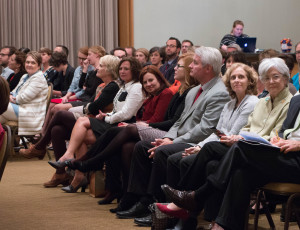 As many people do in the new year, ImpactTulsa is taking inventory of our
As many people do in the new year, ImpactTulsa is taking inventory of our
accomplishments and assessing progress toward our goals. As a collective impact partnership, we ended 2015 proving there is a unified mission to guarantee every child a high-quality education. It was incredibly energizing to stand before a packed room of our city’s leaders from all facets – education, business, faith, philanthropic, non-profit and municipal – to talk about the data analyzed in our 2015 Community Impact Report.
As we look forw
ard to 2016, this will be another aggressive year of doubling down to achieve our 2019 goals:
- 10% increase in 3rd grade reading proficiency
- 10% increase in the on-time partner districts high school graduation rate
- 12% increase in postsecondary entry
- Reduce the gap of the over 3,000 students who are currently not enrolled in quality pre-K programs
A few things you can look forward to from ImpactTulsa in 2016 include:
GradNation
We’ll kick off the year by hosting the GradNation Community Summit this Friday, January 8th bringing together more than 150 Tulsa community officials, business leaders, educators and parents. We found that schools in the Tulsa region experienced graduation rates as low as 44% while others are achieved rates as high as 99%. At GradNation, we’ll collectively explore innovative approaches and develop joint action plans aimed at increasing high school graduation and postsecondary attainment rates. If you haven’t registered yet, there’s still time. Sign up here today.
FAFSATulsa
Learn how you can support our area’s graduates and increase FAFSA completion across the region. It’s easy, and here are a few ways to help: post fliers, include us in your company newsletter and direct people to www.fafsatulsa.com.
Only 53% of 2014 graduates completed the FAFSA form, a free application for federal student aid. We know 65% of jobs by 2020 will require a postsecondary degree, and the economic wellbeing of the Tulsa region is at risk unless we collectively find a way to learn from the bright spots in our region. The resources are there. More than $15 million in federal financial aid was left on the table in our area because graduates didn’t complete the FAFSA form, and with programs like Oklahoma’s Promise and Tulsa Achieves, there is no reason why students shouldn’t be pursuing postsecondary education.
Pre-K Enrollment
Our 2015 Community Impact Report found over 3,000 eligible Tulsa-area students are not accessing our region’s free pre-K system. As a result, they are falling behind in subsequent grades.
Conversely, students attending quality pre-K programs are 33% less likely to repeat a grade through 8th grade, and economically disadvantaged pre-K students are 19% more ready for kindergarten. And from there, the snowball continues. Kindergarten ready students are more likely to be ready to read by third grade, proficient in math by 8th grade and graduating on time.
Stay tuned as we hit the streets in early spring to assist our districts in increasing pre-K enrollment and this critical foundation for our students’ education.
Learning from Bright Spots
Just as we did in 2015, we plan to work together with our 15 partner school districts and focus on the bright spots. ImpactTulsa is committed to using data as a flashlight, not a hammer. Last year, an analysis of reading proficiency scores across our partner districts identified schools that are showing strong outcomes with low-income students. We plan to continue to learn about the instructional and data-driven approaches of school leaders, teachers, instructional coaches, and reading specialists. Read more about the our region’s Literacy Bright Spots here.
